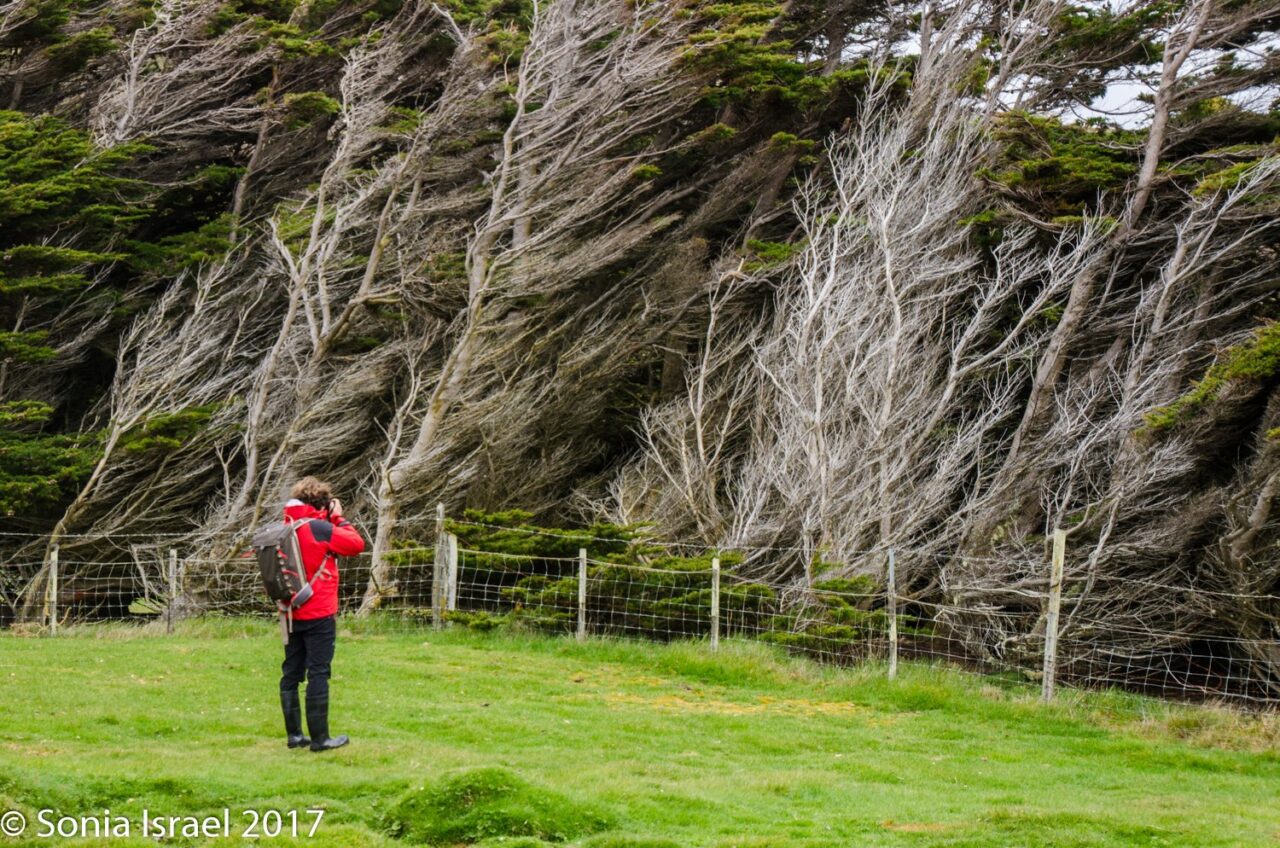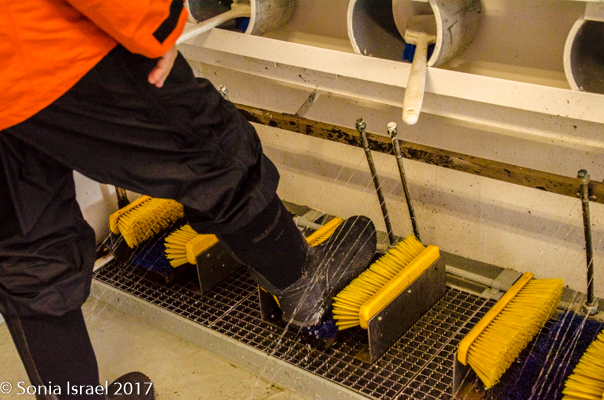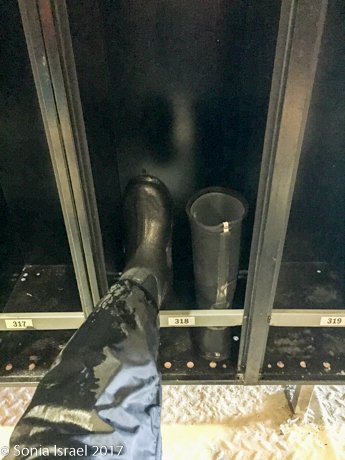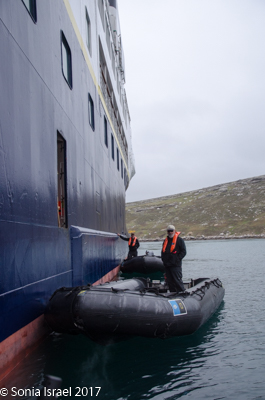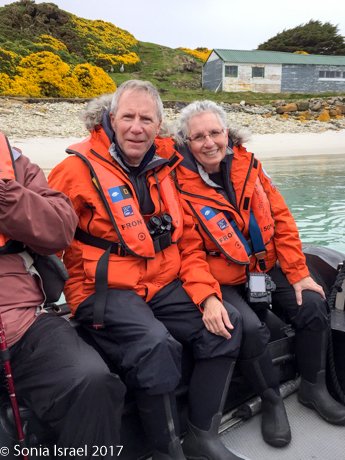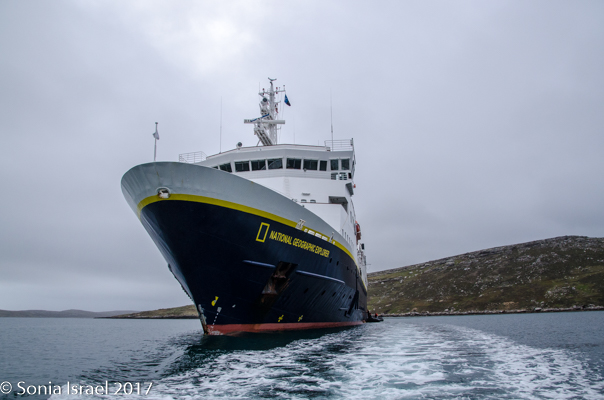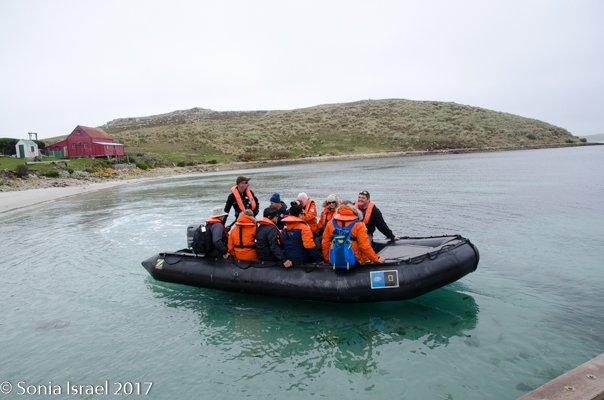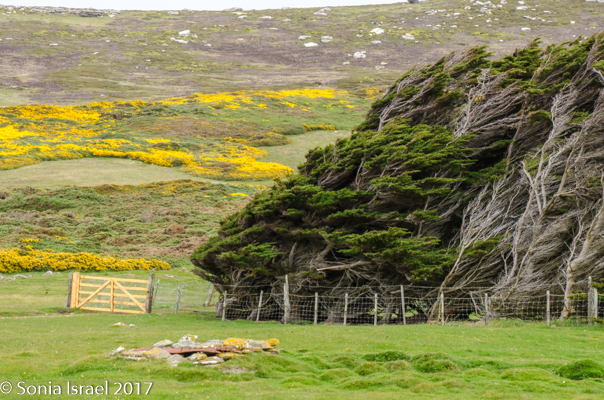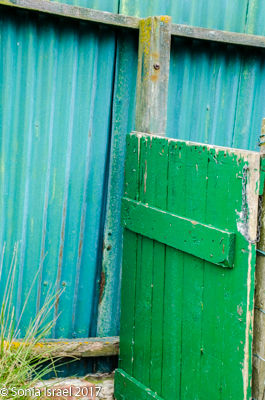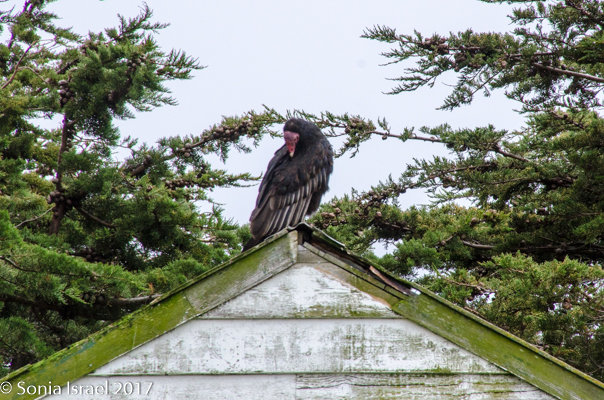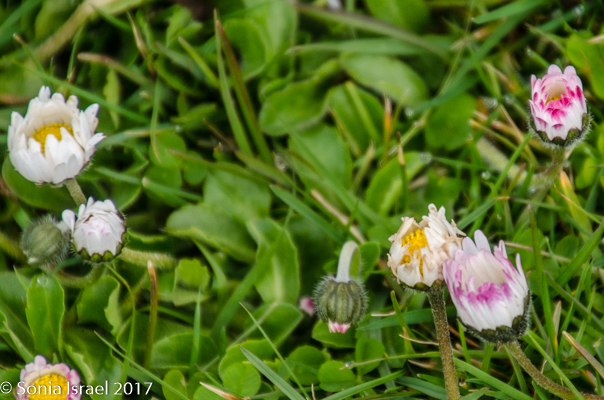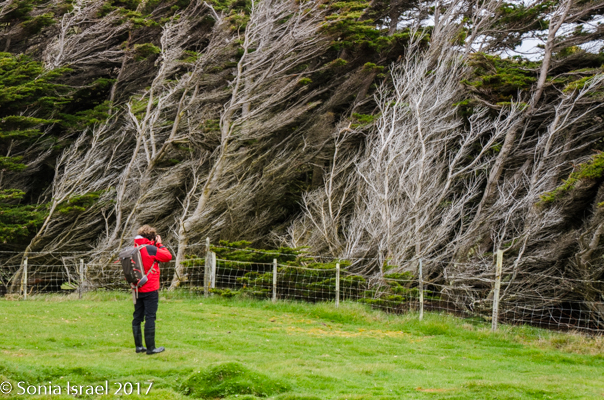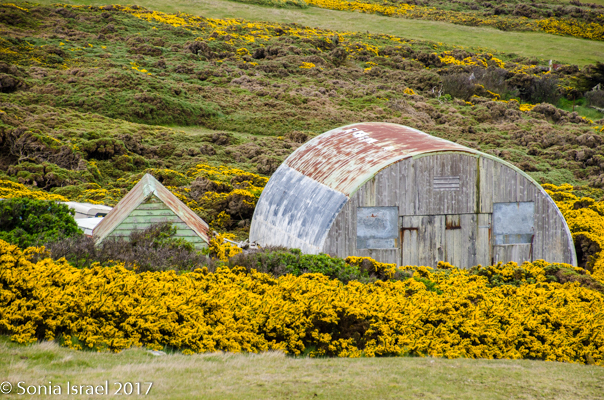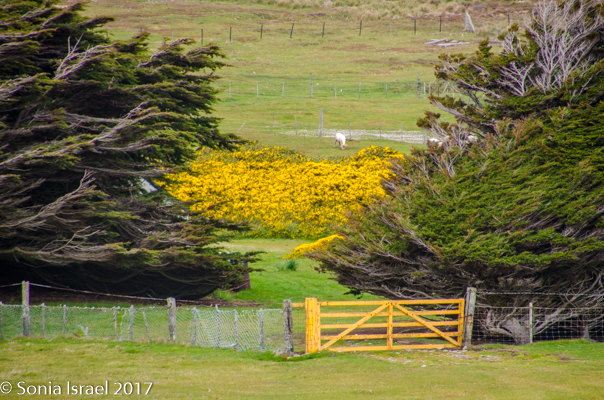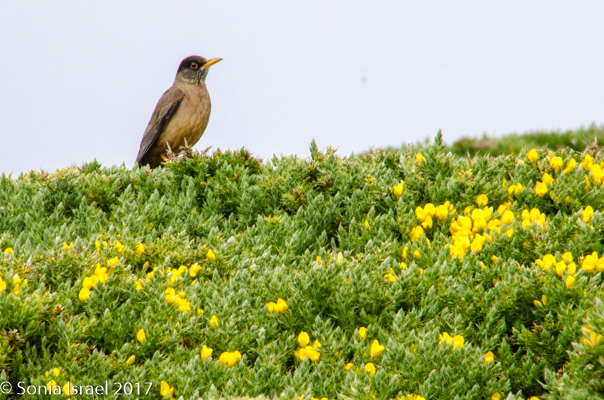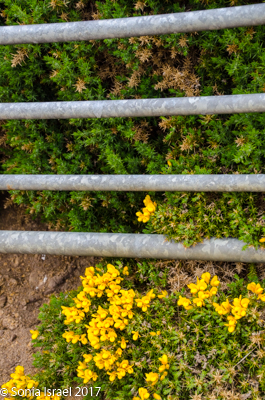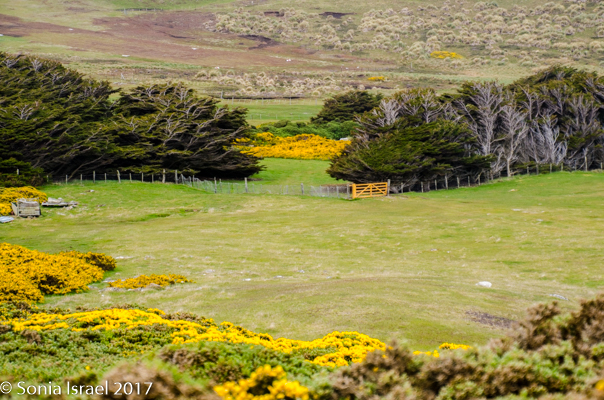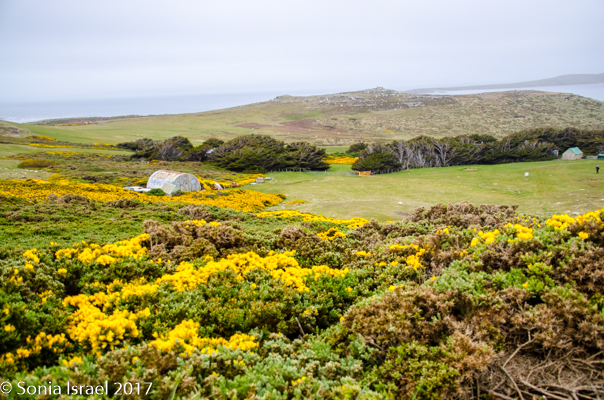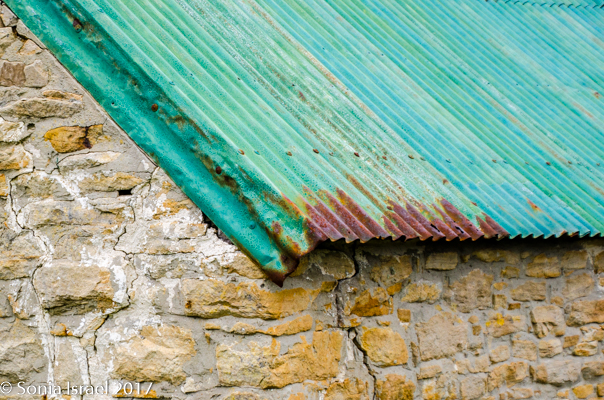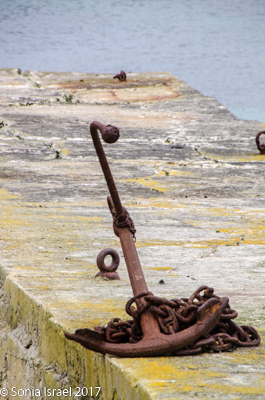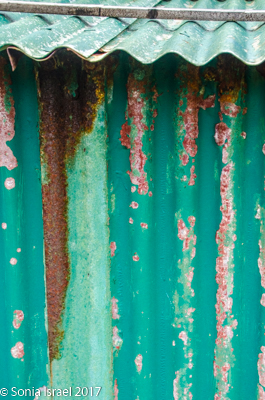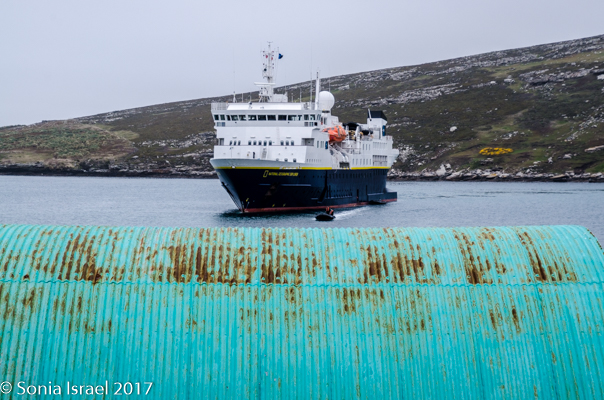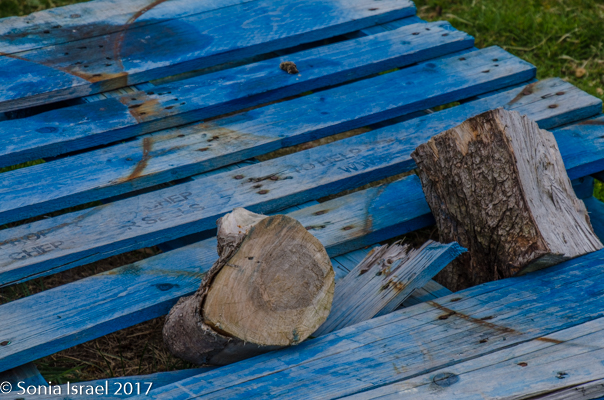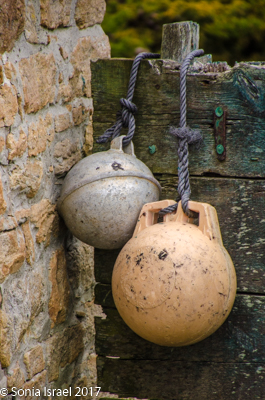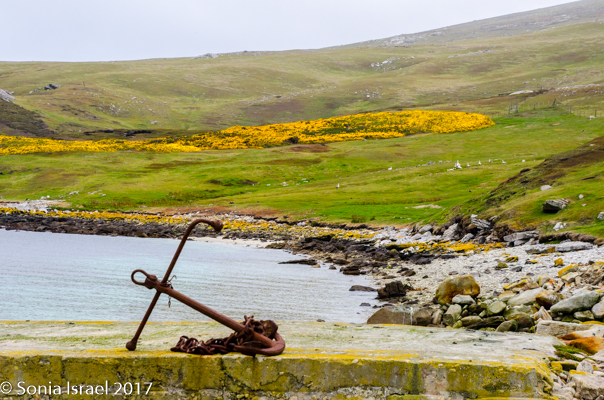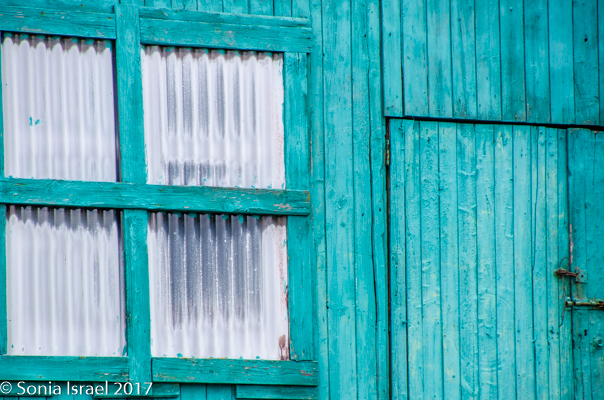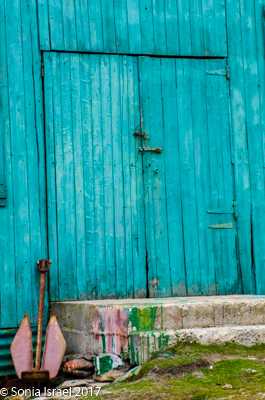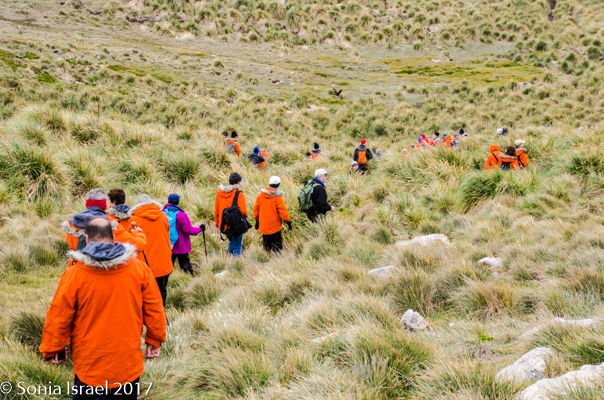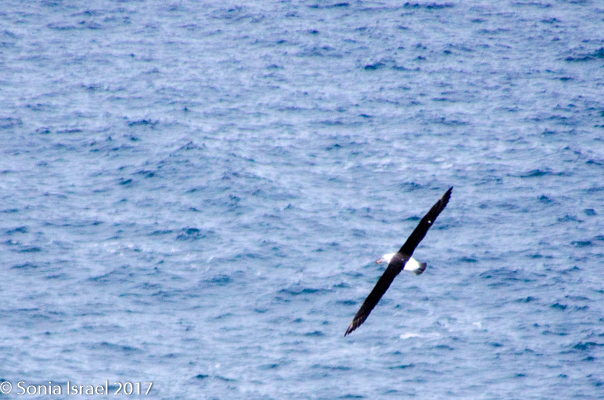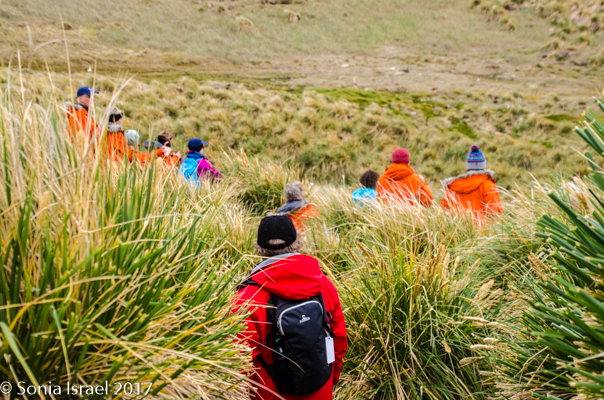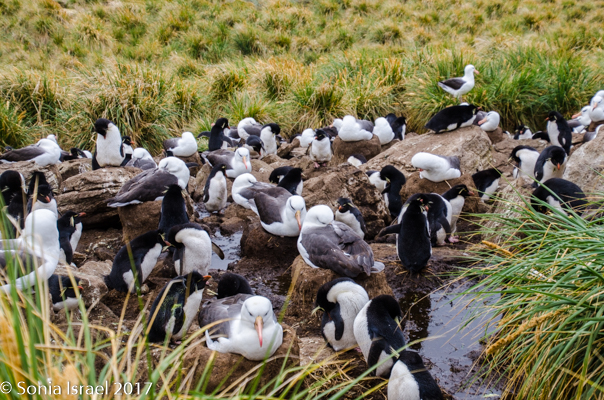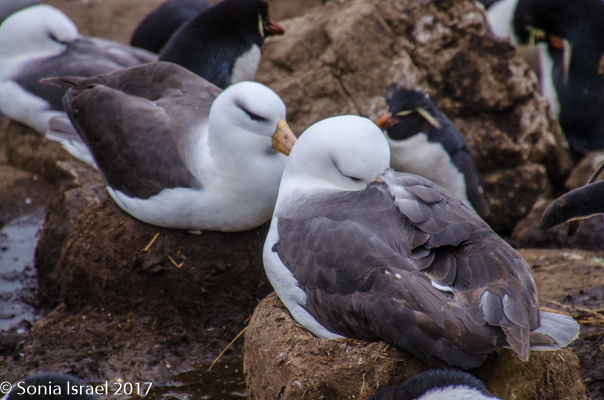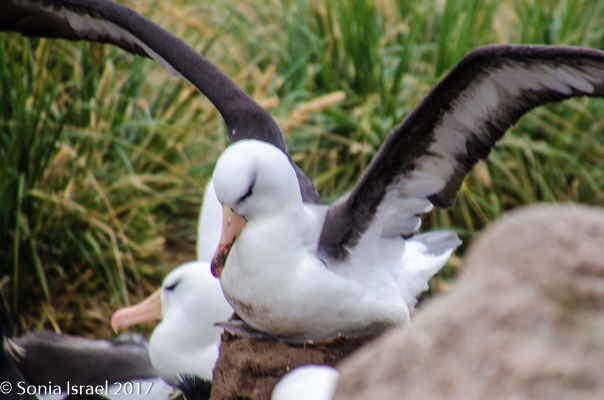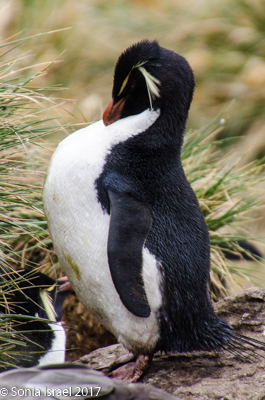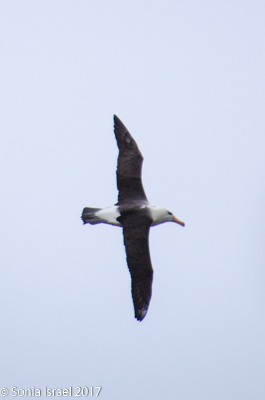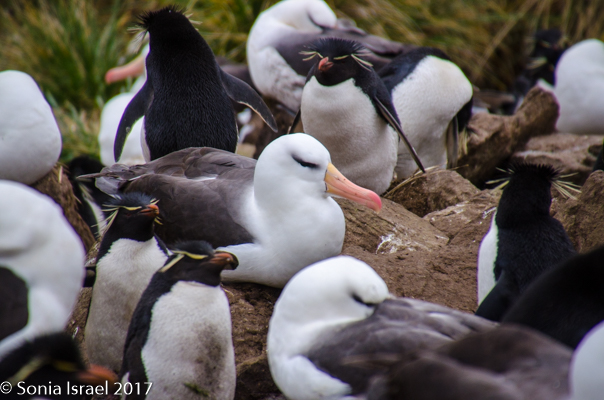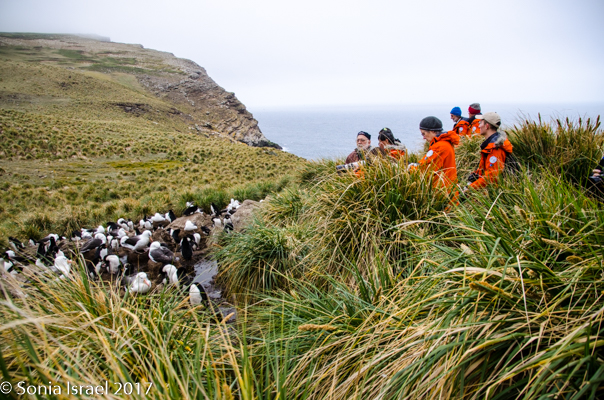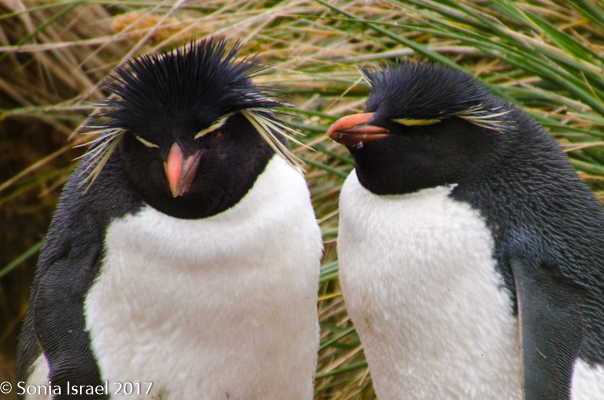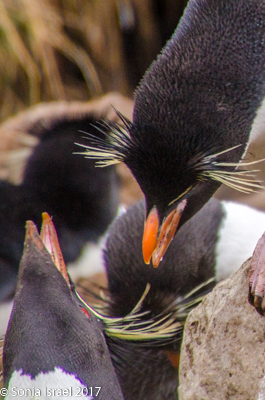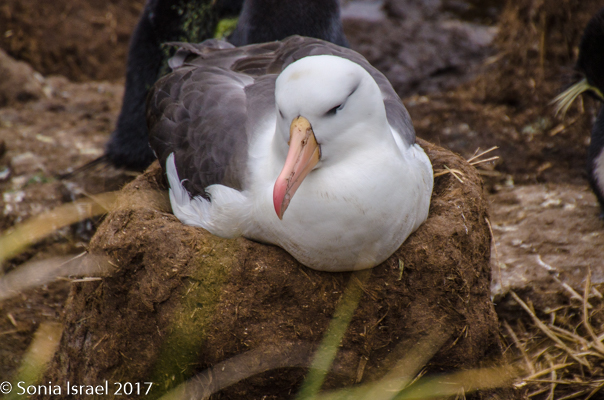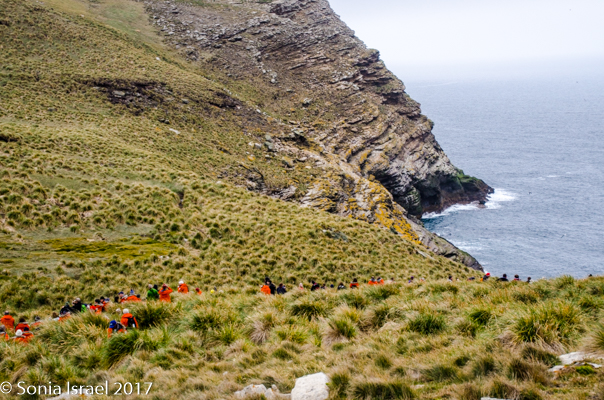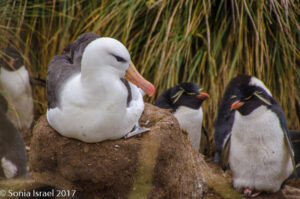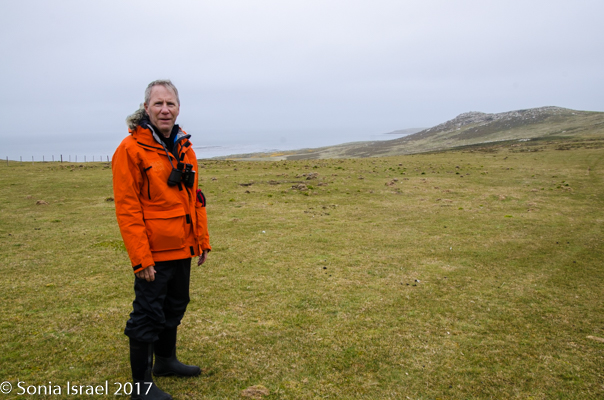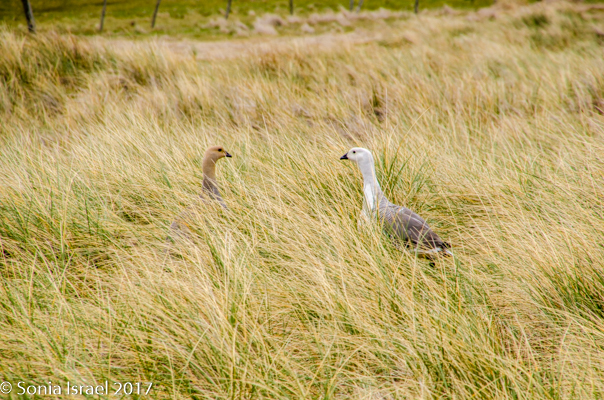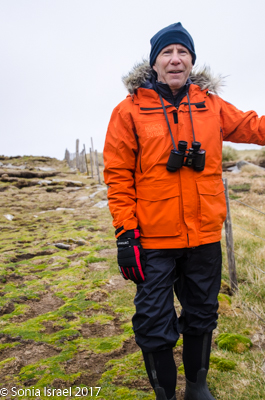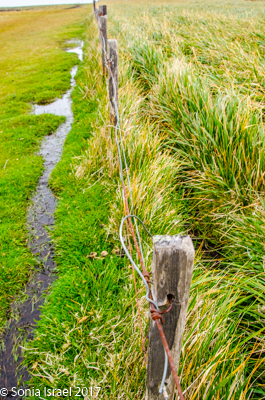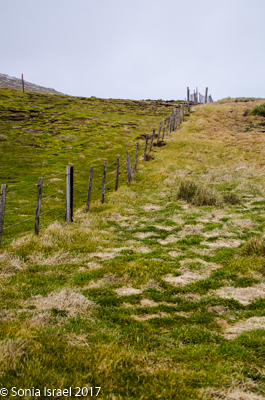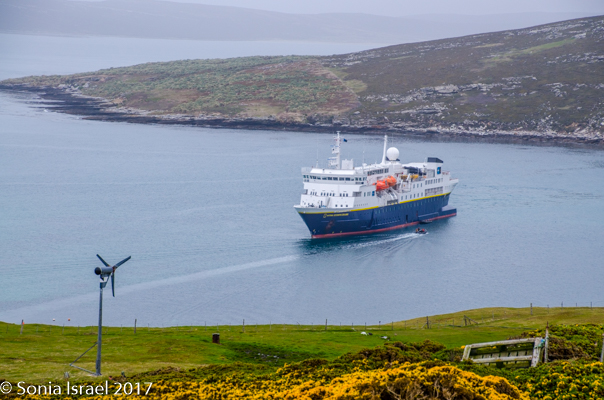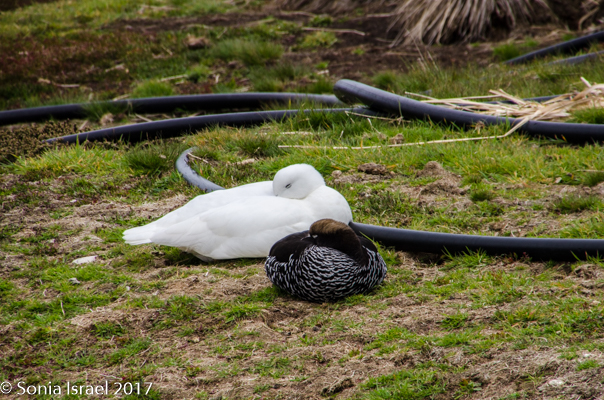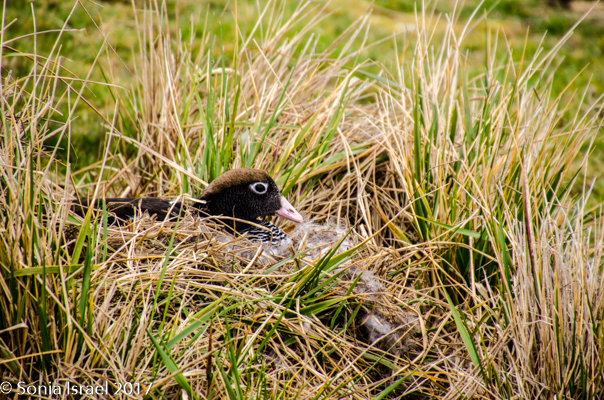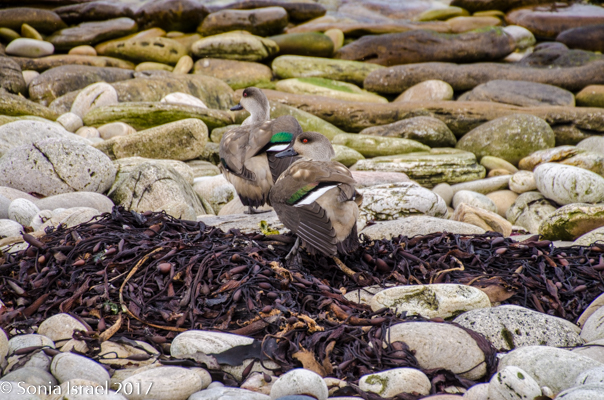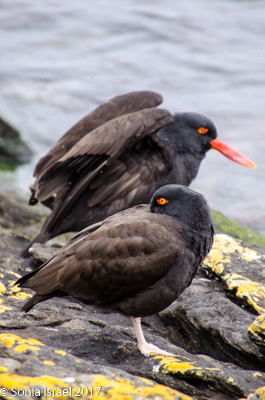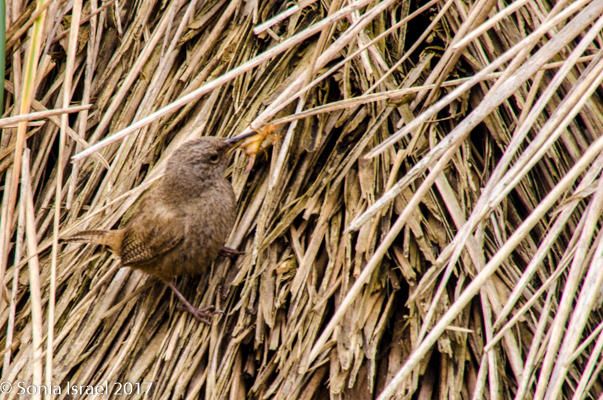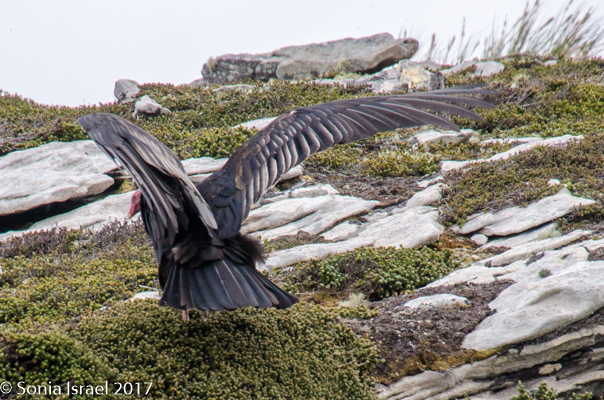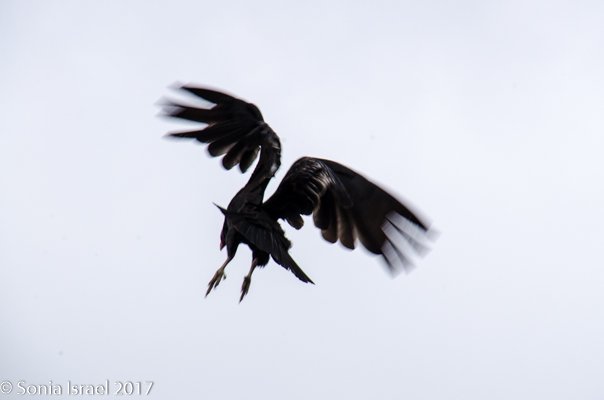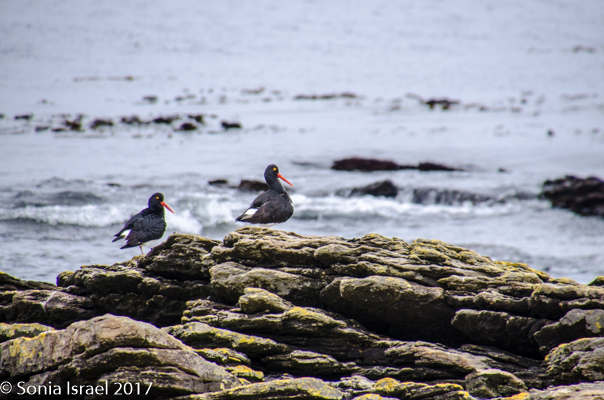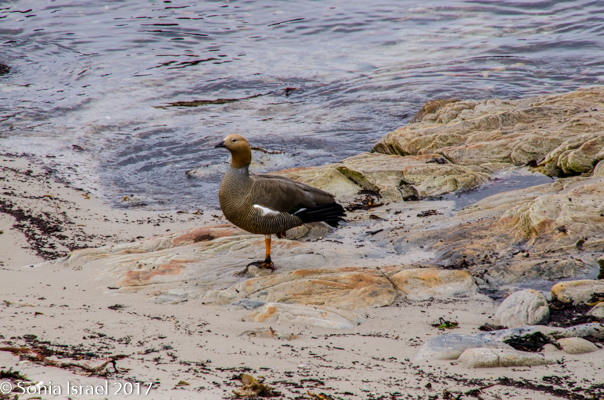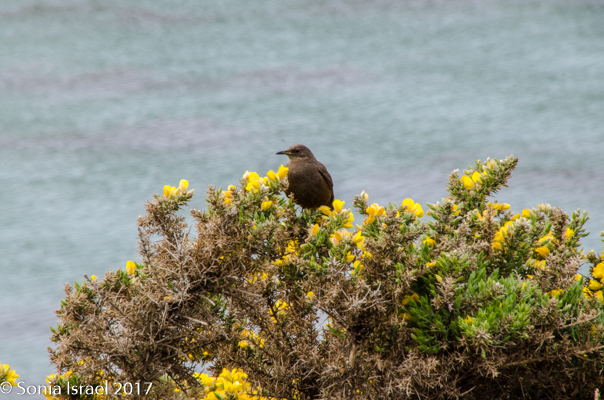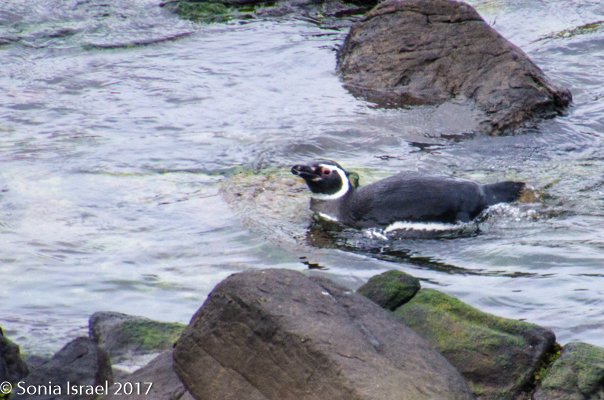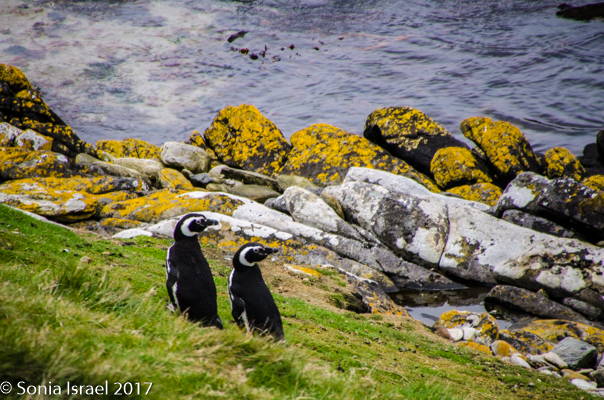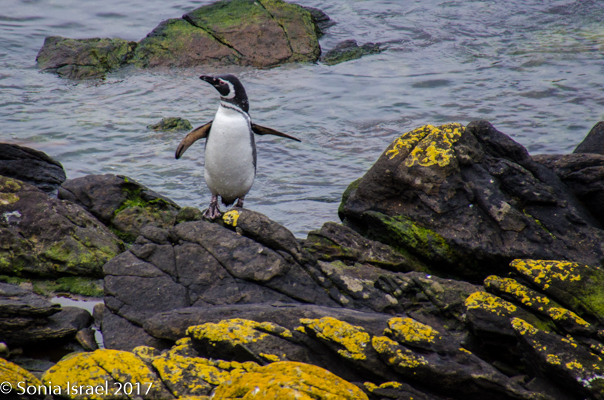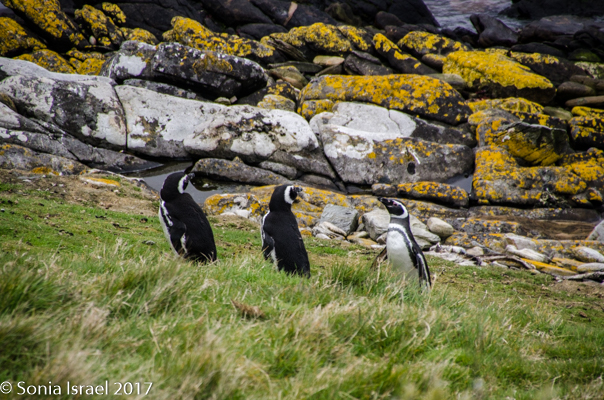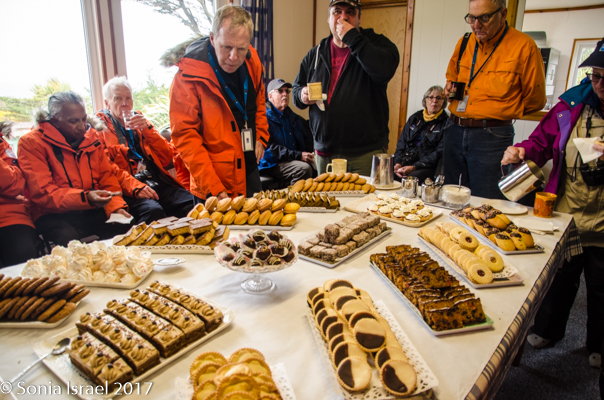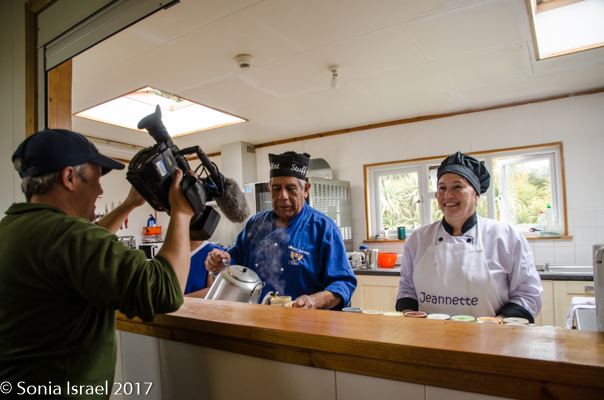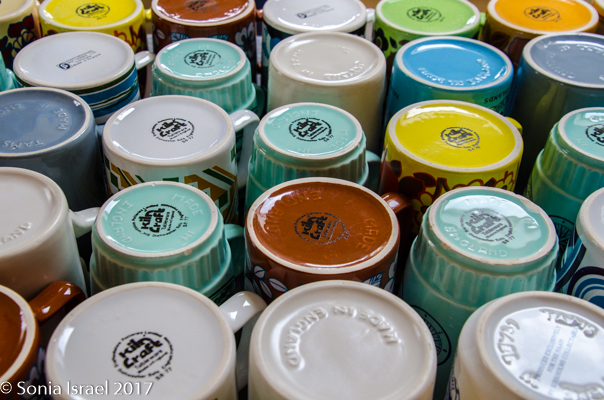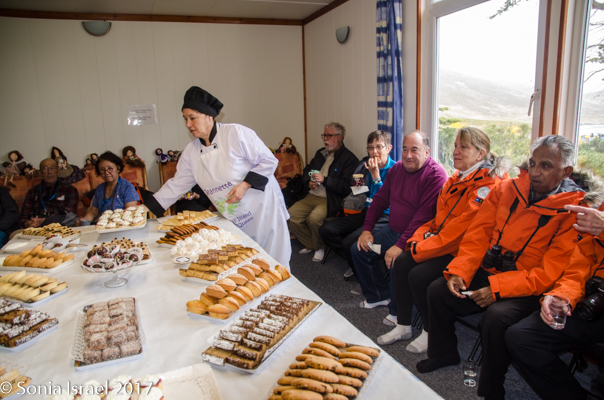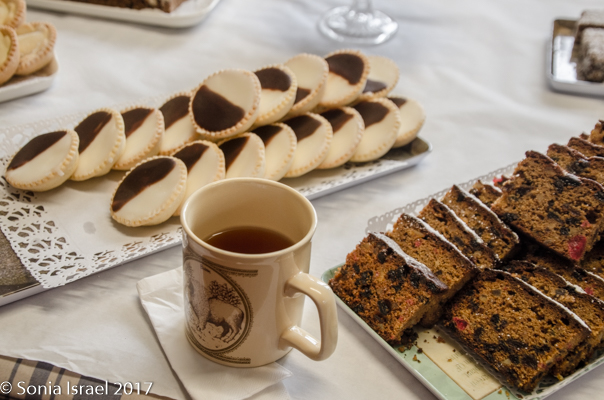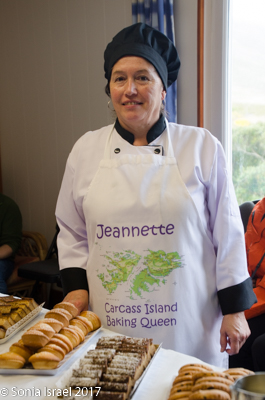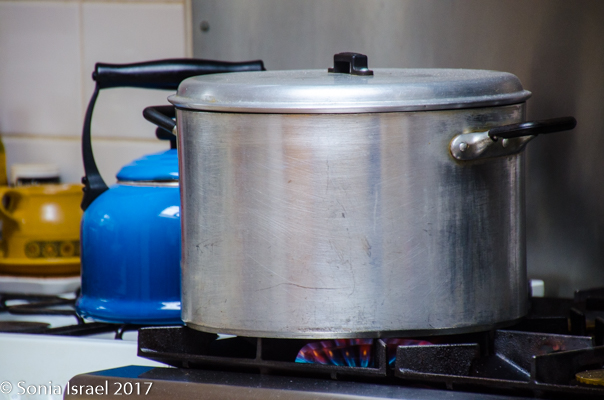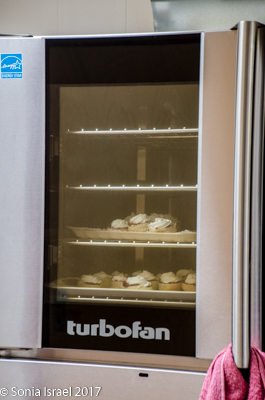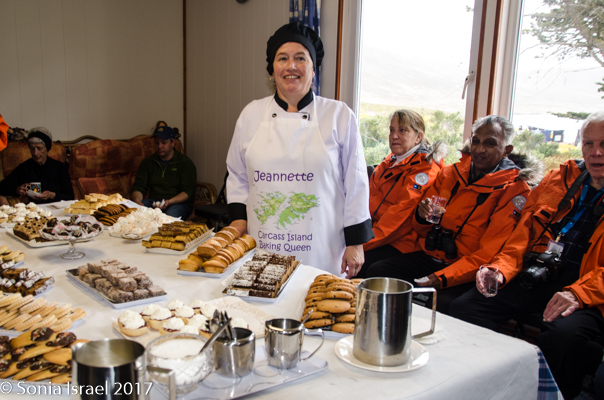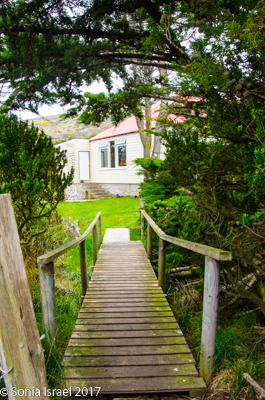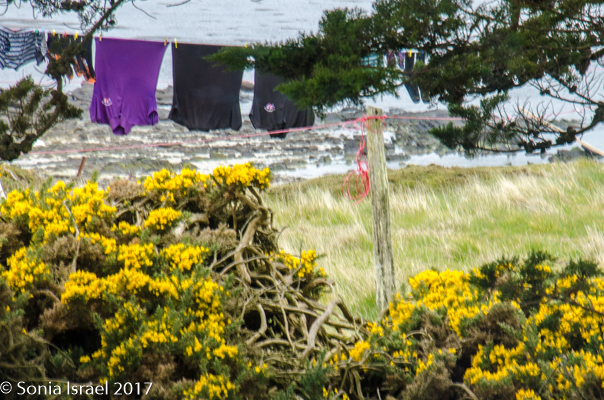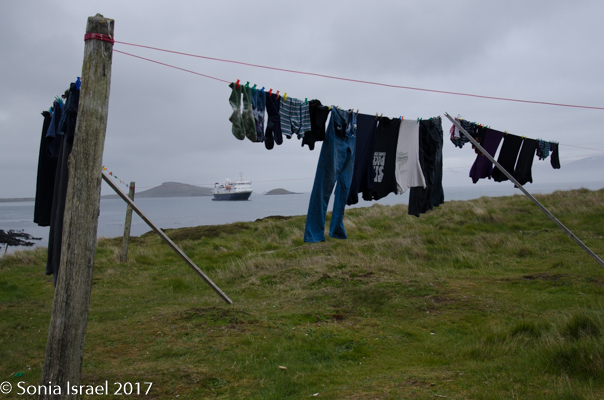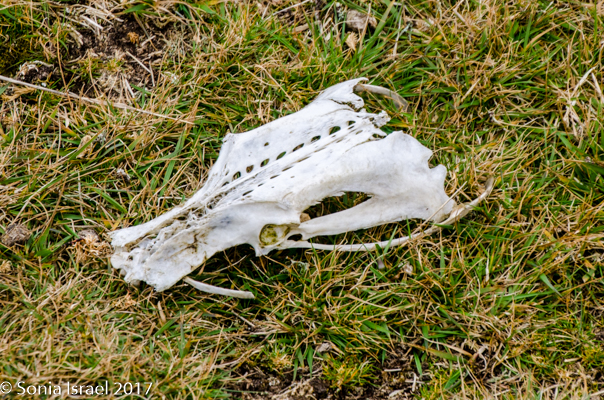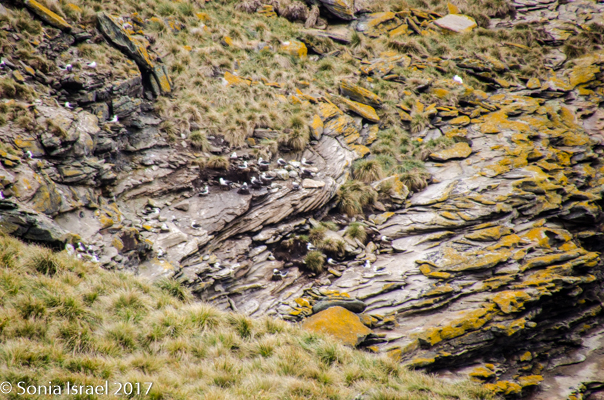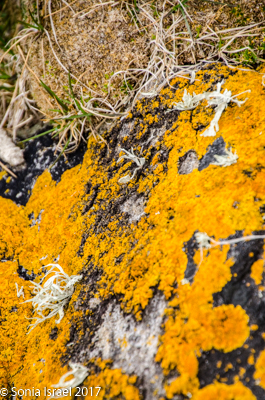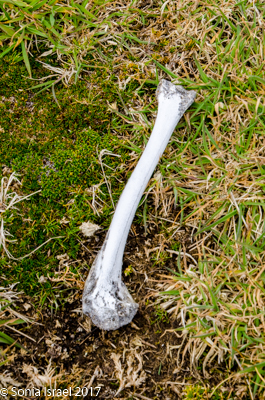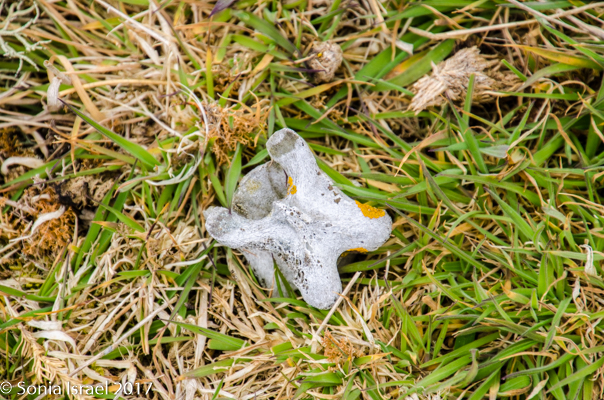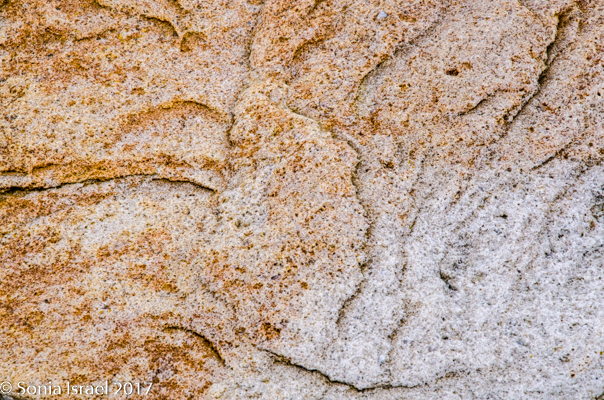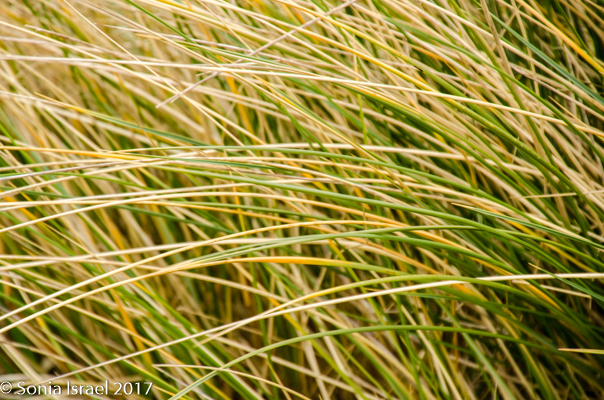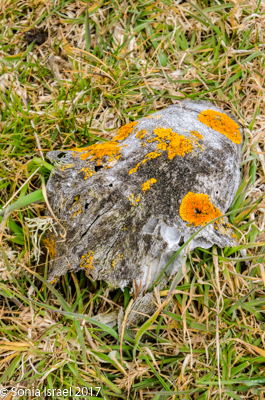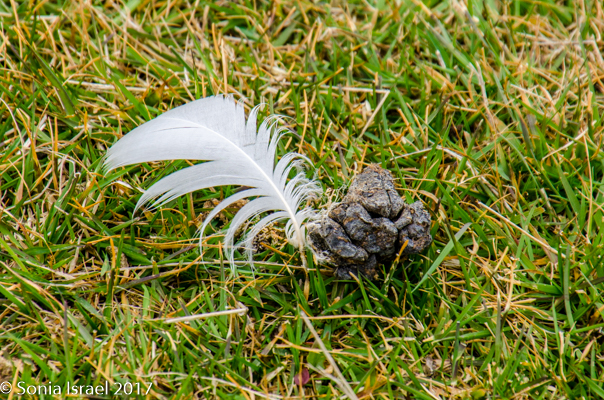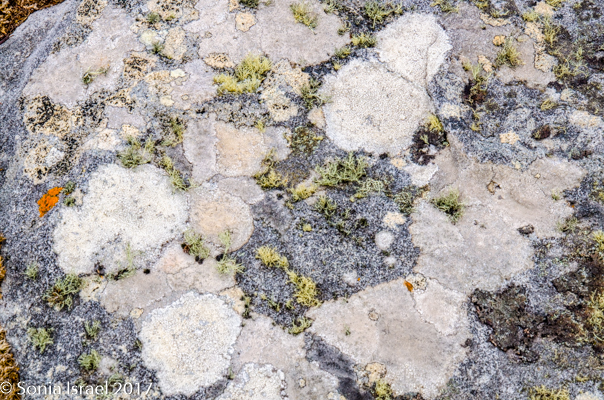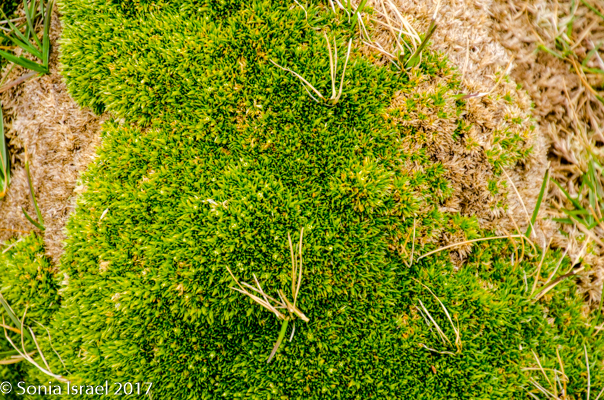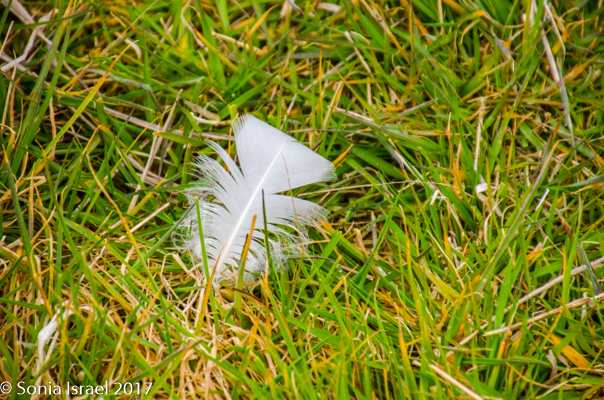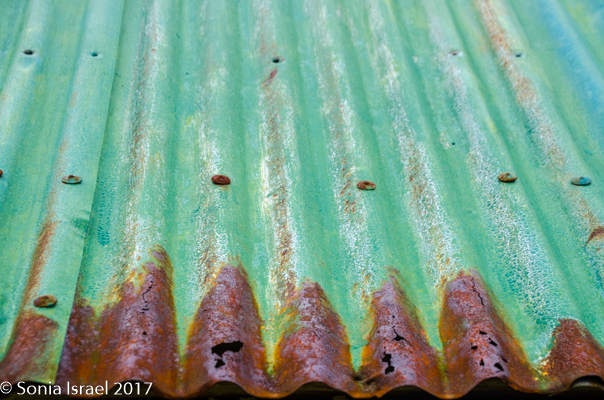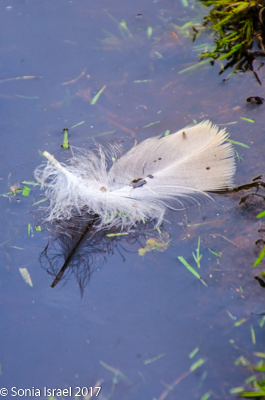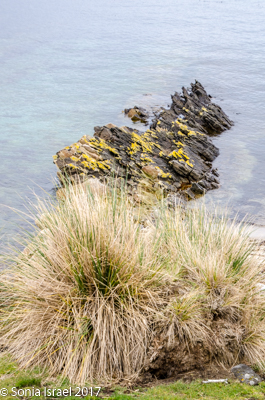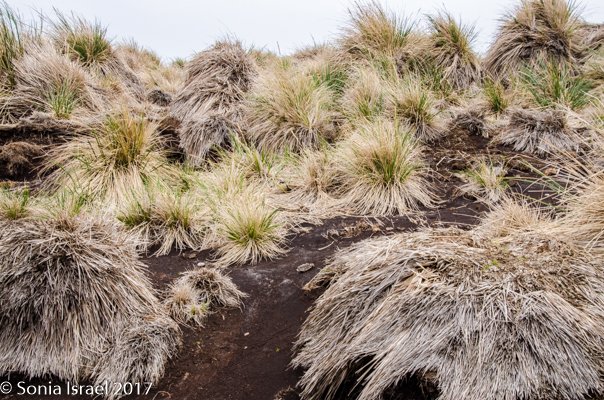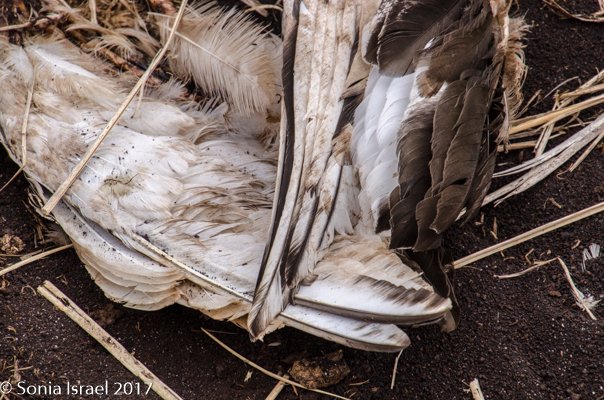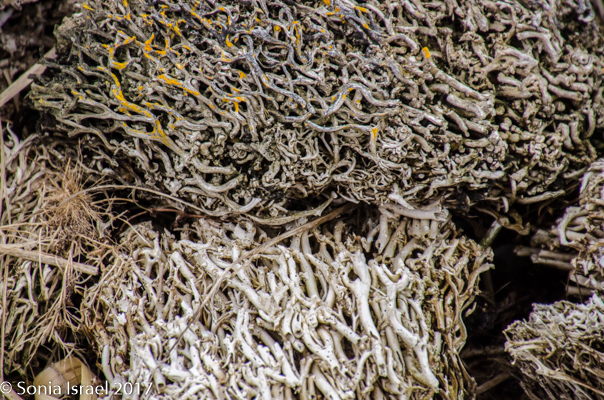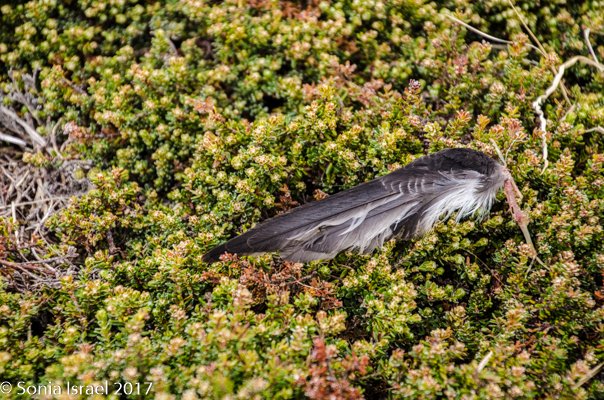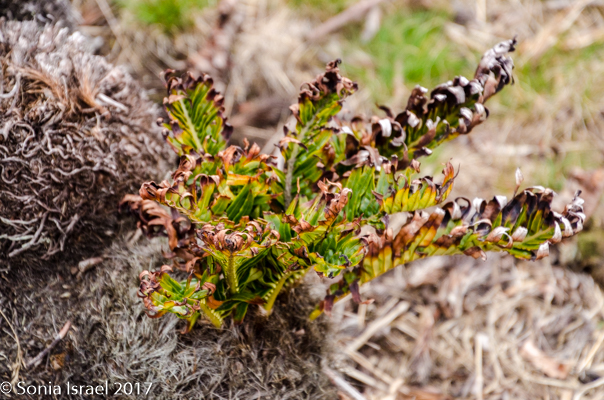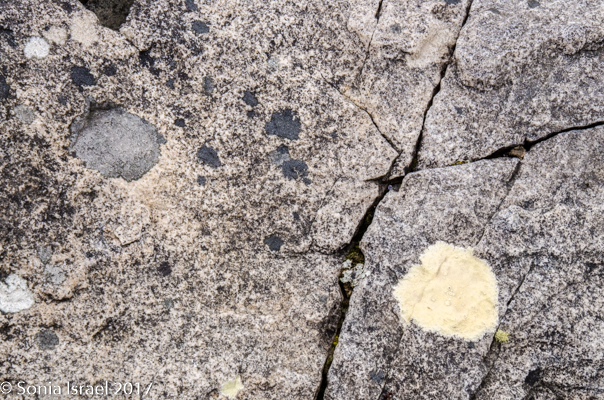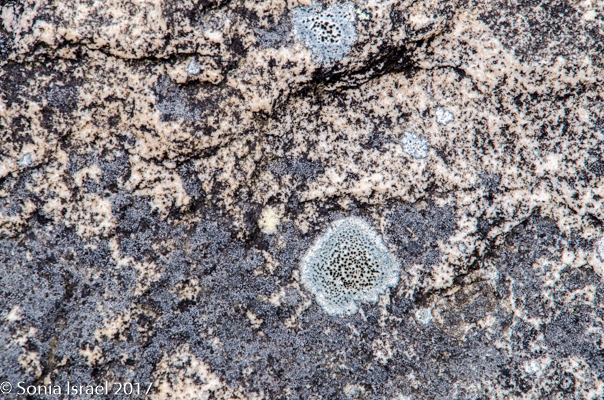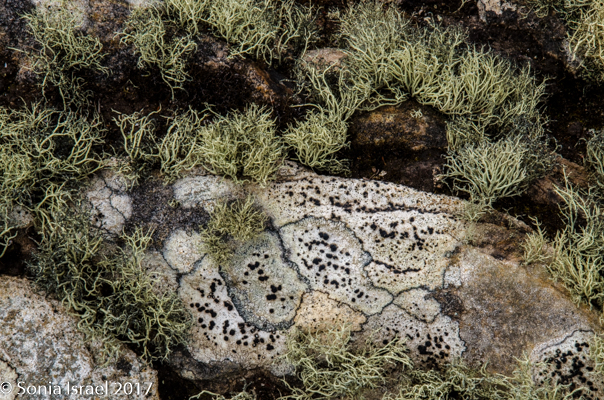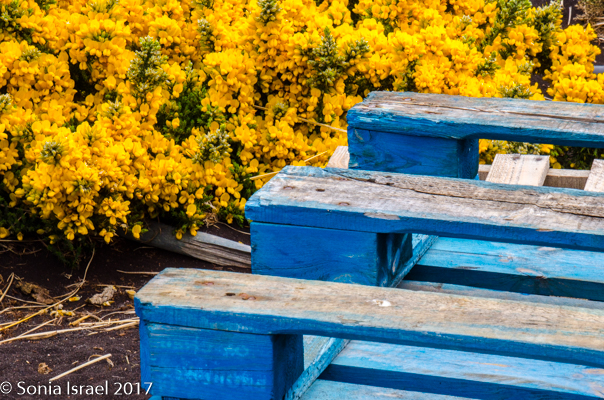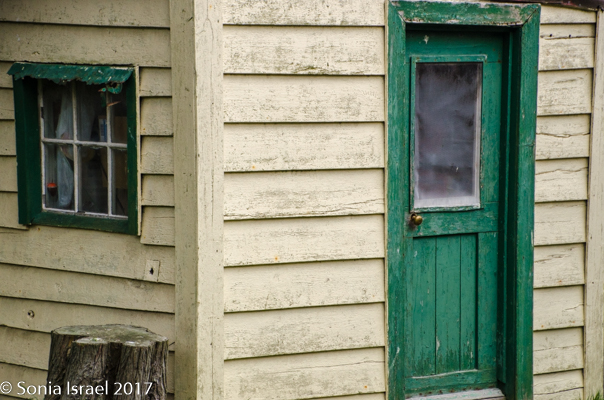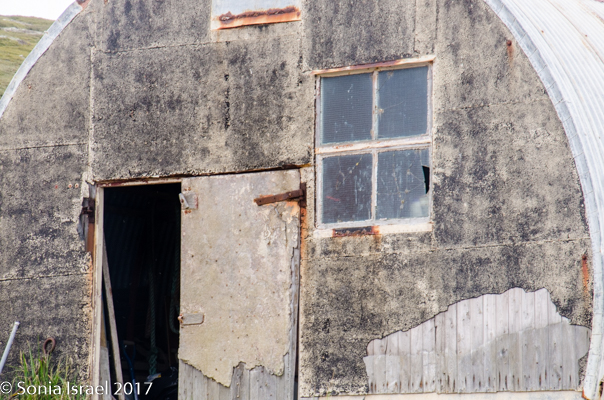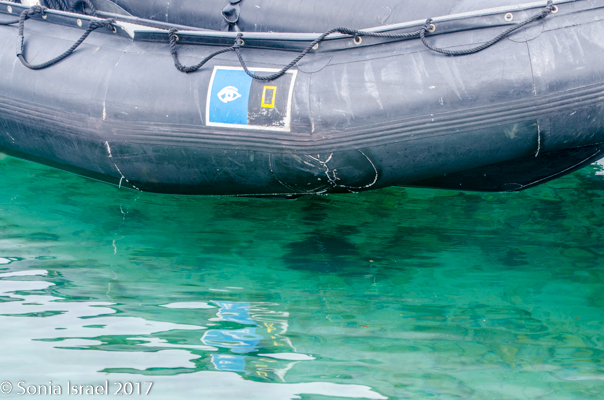Friday, Oct 27, 2017
Today would have been my father’s 95th birthday. Unfortunately, he never lived to see 53. He would have loved that I travel. He loved to travel too. That is probably where I got that gene.
Flying Penguins
I woke up this morning, and as I do every morning, I immediately opened our blinds to look out. This morning I was greeted by the sight of penguins porpoising (not sure if that is really a word, but the penguins were jumping out of the water and “flying” like porpoises do).
(I apologize for the poor quality of the shot, but it was from the windo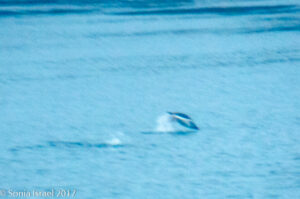 w of our cabin and I had to be quick. But I still wanted to show you what it looked like.)
w of our cabin and I had to be quick. But I still wanted to show you what it looked like.)
West Point, West Falklands
Before long we anchored at Settlement Harbor at West Point Island, West Falklands. After breakfast they began calling the zodiac groups. We were group B. We layered our silk underwear, light wool layer, fleece layer, big orange jacket layer, gloves, hat, camera, plastic bag to keep camera dry and muck boots. And of course, life jacket. And off we waddled, down to the mud room where our muck boots were stored, and put them on. We scanned out, cleaned our boots and climbed into our zodiac. Clean our boots on the way out? Yes, to keep from contaminating the islands with foreign seeds or bacteria. So we cleaned our boots and stepped into disinfectant on the way out and again on the way in. And, while we are on the topic of the mud room, the lockers were set up in a way that we could use the rung to take off our boots. So much easier than trying to just pull them off!
We climbed into the zodiac and headed for land.
Our First Landing
 Our first landing was a dry landing, meaning we stepped out onto a dock. And began what would be a 2.5 mile roundtrip hike, starting up the mountain, with a gradual incline, gaining about 320 feet in elevation over gentle grassy paths. We were on our way to the windward side to see an Albatross nesting colony along with Rockhopper penguins.
Our first landing was a dry landing, meaning we stepped out onto a dock. And began what would be a 2.5 mile roundtrip hike, starting up the mountain, with a gradual incline, gaining about 320 feet in elevation over gentle grassy paths. We were on our way to the windward side to see an Albatross nesting colony along with Rockhopper penguins.
The island is owned by Roddy and Lil Napier and is an active sheep farm since the 1970s. The West Falklands are home to an impressive array of wildlife and we got to see so many different birds. Turkey vultures. Geese. And so many other birds I could not identify. But of course the highlight was the at the Devil’s Nose colony with nearly 15,000 black-browed Albatross who nest here along with several hundred pairs of Rockhopper penguins.
Along the way we admired the aluminum huts, covered in rust. The lichen on the rocks. A bone or skull here and here. Feathers. Geese who totally ignored us. Hedges of yellow gorse, brought from Europe as a living fence as it has thorns, were everywhere, adding to the color. And tussock grass was everywhere. Tussock grass grows all over the Falklands and South Georgia Island. Tussock grows in bunches rather than like a lawn, and on these islands it is very, very, very tall, making it hard to walk through it. Because of the size of the tussock, many birds, including Magellanic penguins, striated caracara, turkey vultures, ducks and geese nest inside the clumps of tussock. There are no native trees here so the tussock spreads all over. The few trees that are here were brought over from other countries, and due to the high winds, grow almost horizontally.
The quiet was deafening. Total silence with a bird calling every now and then. There was a vastness of green, spotted with patches of yellow flowers (not indigenous, but beautiful nevertheless). And dotted with orange jackets. This was almost as remote as you can get.
Nesting Albatross and Rockhopper Penguins
We got to a gate, and were instructed to carefully make our way down a narrow mud path, lined with tall tussock grass, to the colonies. We had to be very quiet so as not to scare the birds. We climbed down, carefully, slowly and then suddenly, the landscape opened up and there they were! Albatross sitting on their nests. Rockhopper penguins all around them. The penguins would open their beaks and screech. The albatross would take off and soar in the sky. But most just slept on their nests, warming their eggs. I could have stood there watching forever. Forever! But after about 15 minutes (maybe more, maybe less), my conscious got the better of me and I decided I better let the other groups have a chance to enjoy this wonderment.
The Albatross
A bit on the albatross. The albatross on the Falklands are black-browed albatross and represent 70% of all breeding black browed albatross in the world. In fact, West Point was once called Albatross Island. The number today is at 20,000 pairs. Not birds; pairs! Their nests, which they return to every year, are a solid pillar up to 20 ins high of mud and guano with some grass and seaweed incorporated. I had never seen any nests like that before. And as we saw here, they frequently nest around the rockhopper penguins.
The Southern Rockhopper Penguin
And a bit on the Southern Rockhopper penguin, a member of the crested penguin family. They weigh only 5-6 lbs (and no, you can’t bring one home). They live in the Falklands, Chile and Argentina and can live for about 25 years. In the Falklands, there are about 280,000 breeding pairs. Pairs! They are great swimmers and hop on rocks – thus their name, the Rockhopper penguin. The males return to the nest before the female does to be sure the nest is ready. I like that! When the female returns, they display and mate. The female lays two eggs, one at a time, a week apart. The parents take turns sitting and incubating the eggs. The one not on the nest goes foraging for food on 7-10 day trips. Once the chicks are hatched, the males will continue incubating them as the babies can’t maintain their heat. In the meantime, the female goes for food. Rockhoppers are serial monogamists. They will switch mates if mating is not successful, but otherwise they stay together. As Jamie, our naturalist said, “Crested penguins stay together, but divorce is frequent.”
After leaving the nesting site, we hiked back up the muddy path, and then back down the grassy paths. Enjoying the quiet. Enjoying the beauty. More birds. More geese. More little flowers. Just plain gorgeous! And this was only the first morning of Day 1!
Carcass Island
After lunch the ship moved around to Carcass Island, owned by Rob McGill and his family. The island is named after the HMS Carcass. A carcass is an early form of an incendiary bomb. Now why would you name a ship, or an island for that matter, after that? Well, the HMS Carcass surveyed the island in 1766. Along the same pattern, its accompanying vessel, the HMS Jason, gave its name to the nearby Jason Islands, and the captain gave his name to MacBride Head.
We got to see a Cobb’s Wren!
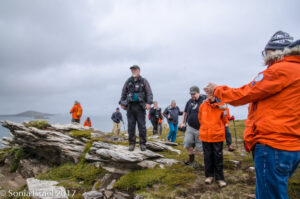 We went on what was called the medium photo walk which was a loop of about one mile with David as our guide. We saw military starlings, Magellanic oyster catchers, blackish oyster catchers, Wilson storm petrels, Kelp geese, Upland geese, Tussock birds (also called the blackish cinclodes) and Cobb’s wren. The Tussock bird and Cobb’s wren are found only in the Falklands. The birds were chirping like crazy. Maybe because we were too close. Maybe because that is just what they do.
We went on what was called the medium photo walk which was a loop of about one mile with David as our guide. We saw military starlings, Magellanic oyster catchers, blackish oyster catchers, Wilson storm petrels, Kelp geese, Upland geese, Tussock birds (also called the blackish cinclodes) and Cobb’s wren. The Tussock bird and Cobb’s wren are found only in the Falklands. The birds were chirping like crazy. Maybe because we were too close. Maybe because that is just what they do.
- oyster catcher
- Cobb’s Wren
- Turkey Vulture
- Turkey Vulture
- oyster catcher
Magellanic Penguins
What we really wanted to see were the Magellanic penguins, as this would be our only opportunity to see them. We saw lots of burrows which the penguins make as their nests, but not any penguins. Until we got almost to the McGill home and there we saw one penguin swimming towards the shore. He hopped onto land and we realized there were two more penguins standing there. They greeted each other, beak to beak, like long lost friends.
Magellenic penguins are “warmer” weather penguins. They molt feathers to lose heat when they are overheating. And they often stand with their feet in water to cool off. On the Falklands, they are called Jackass penguins (I have no idea why). They weigh about 12 pounds, and as just mentioned, unlike other penguins, they nest in burrows. They are found in the Falklands, Chile and Argentina and can live about 20 years.
And as we were watching the Megellenic penguins, we noticed some geese with goslings near them. A little early in the season, but the winter was so mild and spring came early and thus so did the babies.
Jeanette’s Cookies and Tea
We happily walked over to the farmhouse where tea and cookies, cookies made with lots of sugar and butter and therefore delicious, were waiting for us.
- tea mugs
- Stu and Hillary
- Tea and cookies
- Jeannette’s oven
I decided to walk around the farmhouse a bit. I walked over a small wooden bridge into their backyard, at the edge of the island. Out back was a clothesline with clothes blowing in the wind, drying. I love the smell of fresh laundry that dries in the sun. I walked over and then noticed our ship in the distance, looking small but still powerful.
It was time then to go back to the ship. Our young friend had spent time on the beach building a sculpture. And the penguins were still resting and the birds were all lined up by the zodiacs, as if waiting to say goodbye to us.
- Saying good bye to Carcass
Close-ups of the Falklands
In addition to the big picture, the landscapes, the sky, the thousands of birds, there is also the little things. As I walked along, I couldn’t help but notice all the small details. The close ups of the moss, the rocks, the grass, the feathers. A mosaic of beauty. Here are some close-ups of the day.
